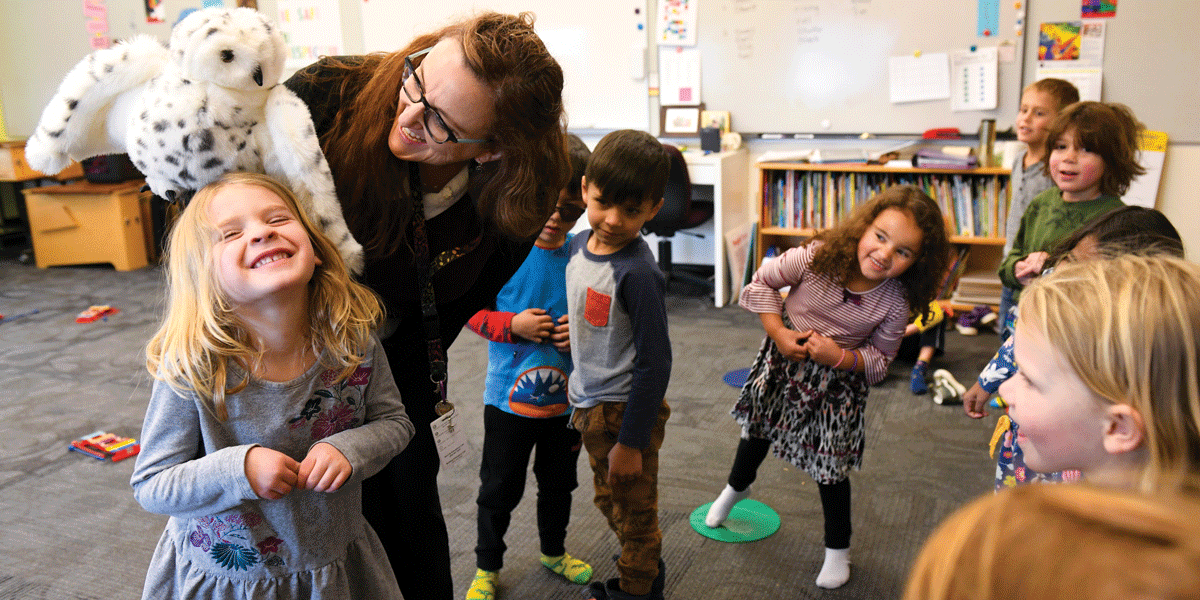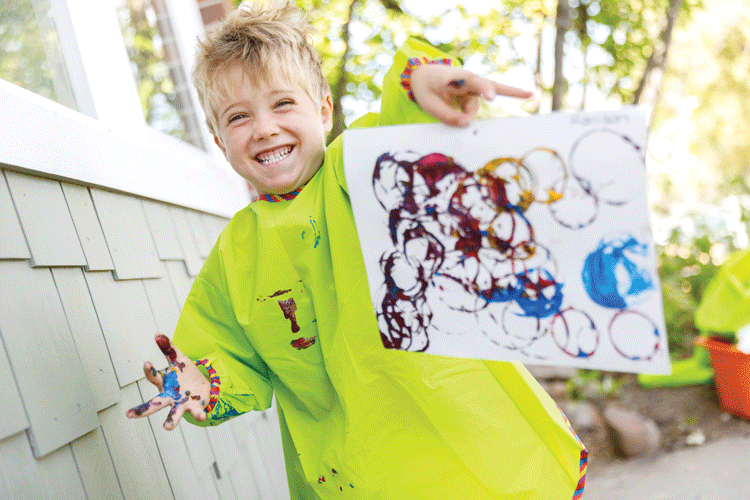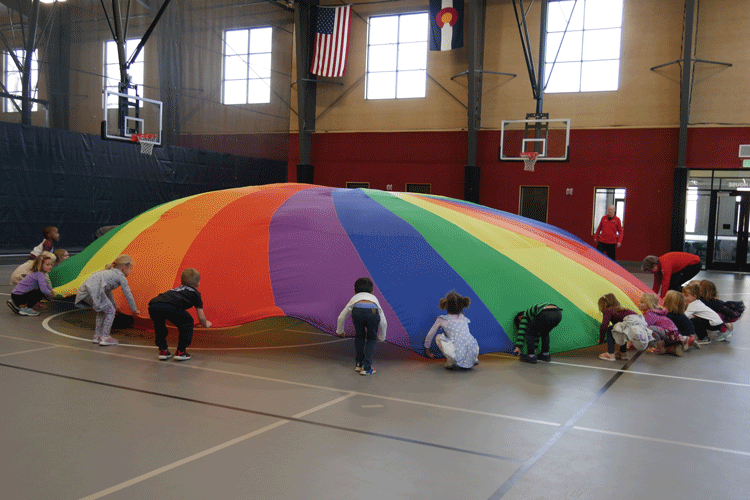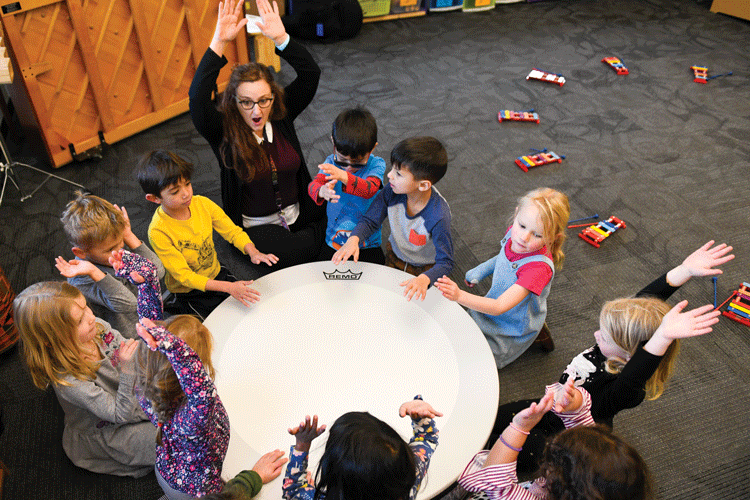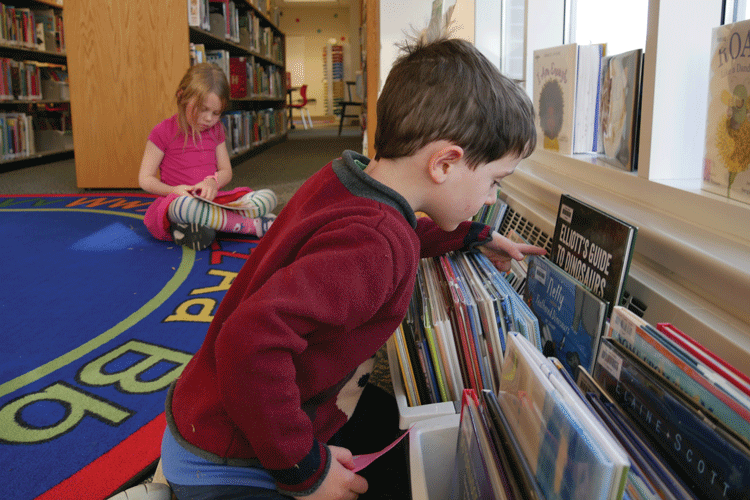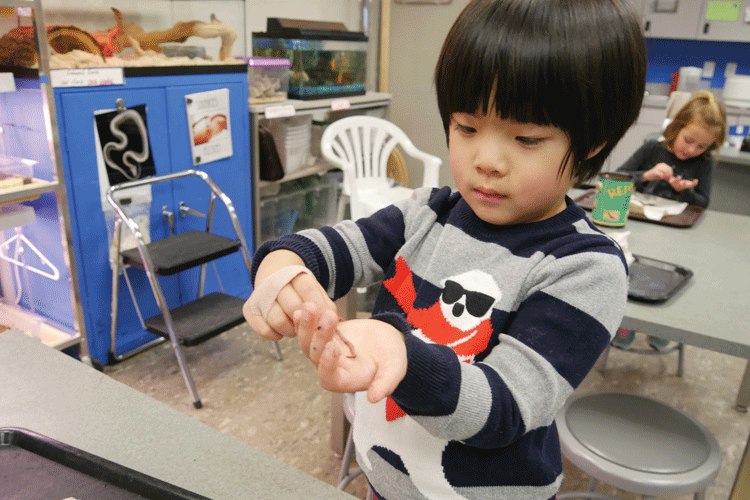The Specials at Colorado Academy Pre-Kindergarten are aptly named. These are times of each day when students leave their classroom to do a “special” activity: dance, music, art, physical education, library time, and science. The same kind of learning happens every day inside the Pre-K classrooms, but the additional time outside the classroom offers students a chance to focus on one activity under the watchful eye of a “Specials” teacher.
“It’s like students get a little field trip almost every day without ever leaving campus,” says Pre-Kindergarten Director Lizzie Rockmore ’90. “It takes what we do in the classroom one big step further, enriches our curriculum, provides a change of scenery, and gives them the adventure of walking around campus and seeing older students.”
Lower School Principal Angie Crabtree sees Specials as CA’s way to expose students to a broad range of opportunities and provide a foundation for future learning. “It may pique an interest or spark a passion for these young students,” she says. “In the future, they will have the chance at CA to dive more deeply into a subject.”
Rockmore likes to refer to the Specials as a source for “hidden curriculum.”
“In Specials, students are practicing skills we are teaching in the classroom, learning without even knowing it,” she says. She also believes it’s good for Pre-K students to see a variety of teachers—and for teachers to see them—“so many people can contribute to the development of a child and help us meet every child’s needs.”
“These Specials teachers have unique training and are passionate about teaching this age group,” adds Crabtree. She is also delighted to see Mustang Mentors from the Fifth Grade helping the teachers in every Pre-K Special. It’s a chance for Pre-K students to meet older students and learn from them. “And in seven years, the Pre-Kindergartners will be Mustang Mentors,” says Crabtree. “That’s the most exciting thing.”
Pre-K Art
Pre-Kindergartners and paint—what could go wrong?
In fact, much goes right when Jorge Muñoz is teaching. He starts the art class by gathering very attentive Pre-Kindergartners, all clad in neon-green smocks, to explain clearly what will happen after they disperse to their individual easels. Each will get two strips of tape to stick to their paper. Then they paint the paper. Finally, they will remove the tape and what remains is their individual masterpiece.
It may seem a simple assignment, but the students are developing complex art skills and habits by using their imaginations, improving fine and gross motor skills, and engaging in creative problem solving. “I am acquainting them with artistic language and basic foundational art skills like collaging, drawing, and painting,” Muñoz says. “We build on these skills as they progress through the art program at CA.”
As students begin to paint, personal styles emerge, even at this young age. Every student applies the tape to their paper with slight variations. Some students are careful to keep each primary color separate on the paper, not touching the tape. Others mix the colors to see what color they can produce. Some start the project cautiously and begin taking risks as they progress. They work independently, but they have many questions. What you hear most often is “Mr. Muñoz? Mr. Muñoz? Mr. Muñoz?”
Their teacher patiently answers each student. He demonstrates what he believes—that art fosters curiosity and wonder, provides an outlet for the imagination that isn’t always present in other areas of learning, encourages creative problem solving, and contributes to a “whole child” approach to learning. In Pre-K Art, students build a foundation for their future at CA, where art is of equal importance with academics and athletics.
“Why not start teaching art as early as possible?” Muñoz says. “You get them going on the right track. They create with wonderment and bring their imaginations to life through their art.”
Pre-K Physical Education
CA Pre-Kindergartners spend plenty of time enjoying freedom and activities provided by recess—riding tricycles, building snowmen, flying through the air on swings. But they also make a regular journey to the CA Athletic Center Field House, where they participate in more organized athletic activities, under the watchful eyes of Coaches Bob Ulrich, Beth Folsom, Dan Pratt, and Hunter Worthley.
Physical Education Special starts off with a burst of speed, as all the students run in a circle around the Field House. It’s a good energy-burning activity. What follows may feel like pure fun to the students, but all the games—whether they involve hopscotch or bunny hopping—help build important locomotor skills. These are the basic building blocks of coordination: walking, galloping, jumping, hopping, side-sliding, leaping, and skipping.
The work students do during Pre-K will create a foundation for Physical Education in Lower School, where the curriculum is built around the study of Kinesiology, with a focus on the characteristics, interests, and needs of the students.
The coaches work with students to organize age-appropriate relay races, with the emphasis on organizing. “They are learning to listen and follow directions,” says Folsom. “In many ways, that is just as important a part of P.E. as the movement skills.”
P.E. ends with a perennial favorite—the giant rainbow parachute. “Everyone hold it with your right hand and walk in a circle,” call out the coaches. There is some fumbling as students remember right from left.
“Now switch to your left hand and walk in a circle,” comes the direction. After the Pre-Kindergartners head out the door back to their classroom, the Field House seems unnaturally quiet. Coach Folsom breathes out. “With Pre-Kindergartners every day is different,” she says. “It’s fun because they are seeing all these activities for the first time, and they are always excited.”
Pre-K Music
Isabella Ubertone’s classroom is a music paradise for Pre-K students, a place where she hopes “I can give them the gift of music.” In every corner, there are different instruments set up, but the students select their favorite within seconds of arriving. They race to the huge drum in one corner, arrange themselves in a circle, and start drumming together. Ubertone, who is also CA’s flute instructor, uses the moment to teach some basic music skills.
“Hands up!” she calls. All hands fly to the air. “Hands down,” she tells them, and the drumming continues. The Pre-Kindergartners think they are having fun, but they are also learning to keep a beat, work together, and follow a conductor. Ubertone has decades of experience teaching music to children, dating back to her own childhood when her mother opened a preschool in her home. “Every day I would go to school to learn, but I couldn’t wait to come home and help her teach,” Ubertone recalls.
After drumming, the students dash to stand on their assigned places, marked with colorful dots on the rug, and sing, first loudly, then quietly. They are learning music dynamics. Then Ubertone segues into what is clearly a favorite activity. She holds a puppet version of Hedwig, the owl made famous by Harry Potter books, and visits each student singing, “Hello, I’m glad you are here today.” The students sing back to her. It feels like fun, but these young students are matching Ubertone’s pitch with their first solos.
Then, it’s time for a new activity as students gather in a circle, each with a glockenspiel in front of them. “Everyone find the orange key,” Ubertone calls out. “That’s the letter A.” Now the Pre-Kindergartners are all percussion players, and what follows is some enthusiastic improvising. “I am playing the piano with my safe hands,” Pre-K student Dylan Driver announces.
“I love teaching Pre-K music, because it is an international language that connects us all,” Ubertone says. “My goal is that at the end of the day, my students have a melody or rhythm that has brought them joy.”
Pre-K Library
At their first visit to the Library of the school year, some Colorado Academy Pre-Kindergartners aren’t sure what to make of this Special. The experience of sitting in a group and listening to stories may be new to them, and it could feel like playtime in a new environment. But very quickly, that changes as Librarians Allison Peters Jensen and Mary Leyva transform their youngest students into great listeners.
By the time mid-December rolls around, Leyva looks out at a group of students gathered on their listening rug, in their favorite listening positions—most of them with legs crossed, or as they would say, “criss-cross applesauce.” Their voices are turned off and their ears are turned on, and it only takes a gentle reminder in case someone forgets how to be an expert in story time listening behavior. Leyva has picked two holiday-themed books to read. When she asks what is on the cover of one book, Yowei Guo’s hand shoots up. “It’s a menorah,” he says. And he is right.
Leyva reads the books to the Pre-Kindergartners with just the right amount of drama, pausing on occasion to ask questions about the characters and the illustrations, to prompt students to make predictions about the story, and to encourage students to make connections between the stories and themselves.
“The fun of reading to this age is in the unexpected,” Leyva says. “You never know what a child will notice in a story. As we discover and learn together, my goal is to create joyful memories that kindle ongoing interest in books and stories.”
As Director of Libraries at CA, Jensen is establishing behavior in the Pre-Kindergartners that will last throughout their career at CA—and beyond. During story time, she believes they develop a rich vocabulary, view many different kinds of art in the illustrations, and make connections between the words and illustrations in a book. They meet a variety of characters, learn how to follow a storyline, and build background knowledge through stories. All of these experiences contribute to increased language development and processing in the young brain.
After Leyva finishes reading two stories, the students get to browse the library. They scatter independently to favorite spots and earnestly look at their options before choosing one special book to check out. “Apart from brain development and the theories of learning, we think it is important for Pre-K students to learn that reading is fun,” Jensen says. “Already, we are starting them on the path to becoming lifelong readers!”
Pre-K Science
Someday, the CA class of 2033 may produce some of the country’s leading scientists, the kind of researchers who change the future with their discoveries. If that’s the case, those scientists could trace the start of their career to Pre-K Science with Jeff Goldstein ’88, or Mr. G., as all the students call him.
Today is a big day for Pre-K in science. They spent their last class building a vermicompost bin. Composting with worms requires a “worm bed.” They collected leaves, tore up old newspapers, mixed them together in a bin, and made certain the mixture was moist with water.
They added a “worm sandwich” out of food scraps, including moldy bread, apple cores, wilted lettuce, crushed egg shells, coffee grounds, and other organic matter.
Then they introduced the red wigglers to their home. Today, they will get to hold the worms and study them closely.
But before that moment, Mr. G. takes the opportunity to turn science class into a vocabulary lesson. “Let’s think about our own beds,” he tells the students, who are gathered on a rug at his feet, fixated on him. “What words would be used to describe our beds?” The hands shoot up and the words come quickly. “Fluffy…cozy…soft…warm…lovey.”
“So now let’s think about a worm bed,” Goldstein asks. “How would you feel lying in a worm bed?” More hands. “Squishy…wet…rough…yucky…pokey…itchy.”
Goldstein brings the vocabulary lesson back to science. “But which bed would a worm rather have?” he asks. “A worm bed!” the Pre-Kindergartners chorus.
The pay-off moment has arrived. Goldstein distributes small piles of
worms from the bed to two-person teams of Pre-K students seated at lab tables. A few make their intentions clear from the start. “I am not going to touch that worm,” they say, only to be overcome by curiosity and end up closely eyeing the worm in their hand.
The students will continue to feed the worms kitchen scraps, observe decomposition, and study the worms.
Ask Goldstein what makes Pre-K Science special, and it comes down to one word for him. “It’s all magical to them,” he says. But watching him teach, you begin to suspect that there’s still magic in it for him as well.
